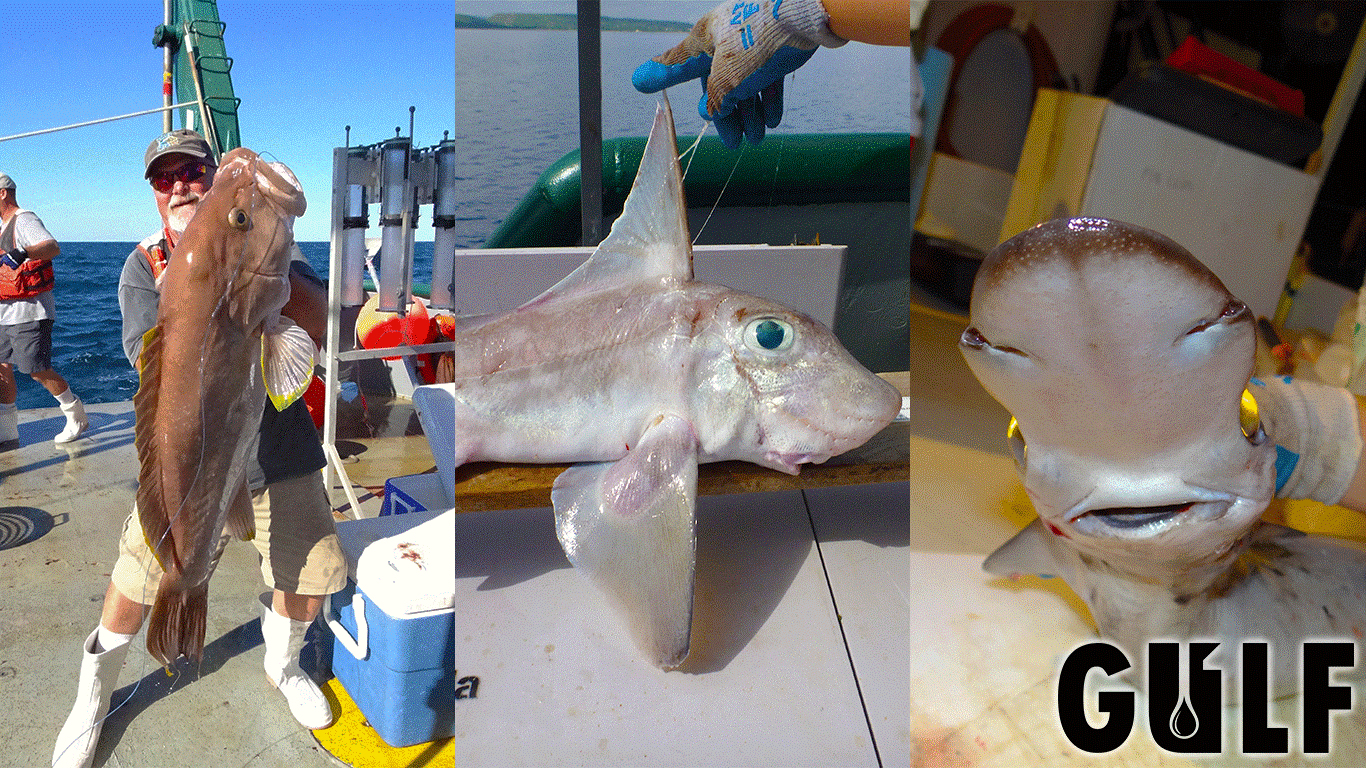Study Gives First Comprehensive Gulf-Wide Fish Surveys in US, Mexican, and Cuban Waters
– NOVEMBER 1, 2018
An international science team studying oil spill effects on marine ecosystems completed 12 research expeditions over seven years and produced the first fisheries-independent, multinational Gulf-wide fish survey. The team caught over 15,000 fish, representing 166 unique species, from 343 longline sets using 153,146 baited hooks. Analyses revealed spatial and temporal patterns of dominate species, including significant horizontal zonation patterns, and differences in fish density and sizes across six semi-discrete subareas: West Florida Shelf (WFS), North-Central (NC), Northwest (NW), Southwest (SW), Yucatan Peninsula (YP), and Cuba. The specimen collections provide a Gulf-wide fish health baseline and a means to understand fish populations’ interconnectivity. The collections also identify the resiliency potential of species assemblages and areas particularly vulnerable to acute and chronic stressors from overfishing, climate change, pollution, habitat loss, and invasive species. The sediment and water sample collections provide a baseline for determining effects from future oil spills.
The researchers published their findings in Marine and Coastal Fisheries: Comparative abundance, species composition, and demographics of continental shelf fish assemblages throughout the Gulf of Mexico. The Marine and Coastal Fisheries journal recognized this paper as one of ten original and innovative studies during the journal’s first 10 years.
Environmental stressors can affect the diversity and demographics of fish species living in large marine ecosystems. Previous studies have evaluated the species assemblage and abundances of these fish, but were often restricted to spatial subsets or specific environmental management issues.
Researchers used systematic collection methods to sample multiple species simultaneously at 40-300 meter depths and employed a statistical design amendable to robust comparisons over space and time. They classified specimens as one of four species groupings (snappers/groupers, elasmobranchs, other demersal species, and pelagic species); evaluated species distributions in relation to their average bottom water temperature and depth; and determined abundance, species richness, and diversity using the Shannon-Wiener diversity index.
The team included researchers from the University of South Florida, Harte Research Institute for Gulf of Mexico Studies at Texas A&M University-Corpus Christi, the Universidad Nacional Autónoma de México, and the University of Havana. “Neither the fishes nor oil spills know national boundaries,” said study author Steven Murawski. “Providing seamless data for the Gulf as a whole is imperative if we are to prepare adequately for future oil spills. The archive of data and samples from these cruises will support projects to look at contaminants, life histories of animals, and fish community dynamics for many years to come.”
Fish abundance, species richness, and diversity were highest in mid-shelf depth (~100 m) and then declined by about half in deeper waters. The northern Gulf (NW and NC) exhibited higher average multispecies abundance, but a shallower multispecies size spectra slope (an integration of mortality, recruitment, growth, and species interactions among size groups) compared to the SW, WFS, Cuba, and YP areas. The northern Gulf is also where the Deepwater Horizon incident occurred, where much of the U.S. oil and gas offshore infrastructure exists, and where the highest frequency of hurricane disturbance has occurred over the past 150 years. The results suggest possible impacts to productivity at lower food chain levels and overall mortality.
The NW and Cuba subareas had significantly fewer species than the other areas. Even though these subareas are adjacent, the NW appears less resilient overall to pulse-type stressors, such as a catastrophic oil spill, because it contains a widespread nepheloid layer that may limit benthic productivity, low habitat diversity, and lower levels of primary productivity. This finding is a paradox for the Cuba subarea given that it contains abundant coral reefs which are thought to be highly diverse. However, other observations have stated that nearly 80% of Cuban marine fishery stocks were overfished or collapsed, which could limit the availability of large economically valuable fishes.
Snappers and groupers were most abundant on the WFS and Cuba; elasmobranchs (sharks, rays, skates) were most abundant in the NC and NW areas; and pelagic species were densest off Cuba. Relatively shallow, warmwater species (Red Grouper, Atlantic Sharpnose Shark, and Red Snapper) were most abundant at depths less than the average depth sampled and where average bottom water temperatures were higher than the average sampled. Conversely, the deep, cold-water species (Gulf Hake, Shortspine Dogfish, and Tilefish) were at depths deeper than the average depth sampled and at temperatures lower than the average sampled. The abundance of other demersal fishes was similar across the Gulf, with the exception of Cuba. Pelagic species (tunas, Great Barracuda, etc.) were relatively rare everywhere (from use of demersal longline gear), but were most dense in Cuba and YP subareas. These findings indicate that continental shelf fishes are structured both vertically (by depth) and horizontally, potentially due to differences in fisheries management between countries.
Murawski said that their expeditions provided an opportunity to collaborate with scientists studying oil spills and related phenomena throughout the Gulf of Mexico, including Mexico and Cuba. “The southern connections were facilitated by our partnership with Dr. Wes Tunnell [who recently passed away], Harte Research Institute, who was a key person in getting access to the IXTOC-I blowout site in the Campeche region off Mexico. We will very much miss Wes’ guidance, perspective and positivity making such complex projects as ours a possibility.”
Murawski explained the significance of thinking about the Gulf of Mexico as an integrated whole instead of three separate national domains, “With the advent of large-volume, ultra-deep oil production, future accidents in this domain will affect all three countries no matter where they originate. Working together, we can reduce the likelihood of accidents like the Deepwater Horizon oil spill and be better prepared to respond should they occur.”
Data are publicly available through the Gulf of Mexico Research Initiative Information & Data Cooperative (GRIIDC) at doi:10.7266/N7G73C4N.
The study’s authors are Steven A. Murawski, Ernst B. Peebles, Adolfo Gracia, John W. Tunnell, Jr., and Maickel Armenteros.
For more information:
Read OneGulf Voyage Gathers Unprecedented Marine Samples for Two Oil Spills and listen to these podcasts:
- Ixtoc Spill: Reflections featuring scientists Wes Tunnell and John Farrington
- In the Mud in Mexico featuring scientist David Hollander
- US and Cuban Scientists Join Forces to Protect Shared Marine Ecosystem featuring David Hollander, Steve Murawski, and Maickel Armenteros
By Nilde “Maggie” Dannreuther and Stephanie Ellis. Contact maggied@ngi.msstate.edu for questions or comments.
************
This research was made possible in part by a grant from the Gulf of Mexico Research Initiative (GoMRI) to the Center for the Integrated Modeling and Analysis of Gulf Ecosystems II (C-IMAGE II). Other funding sources include the National Marine Fisheries Service (NA11NMF4720151) and the Louisiana Oil Spill Coordinator’s Office.
The Gulf of Mexico Research Initiative (GoMRI) is a 10-year independent research program established to study the effect, and the potential associated impact, of hydrocarbon releases on the environment and public health, as well as to develop improved spill mitigation, oil detection, characterization and remediation technologies. An independent and academic 20-member Research Board makes the funding and research direction decisions to ensure the intellectual quality, effectiveness and academic independence of the GoMRI research. All research data, findings and publications will be made publicly available. The program was established through a $500 million financial commitment from BP. For more information, visit https://gulfresearchinitiative.org/.
© Copyright 2010-2018 Gulf of Mexico Research Initiative (GoMRI) – All Rights Reserved. Redistribution is encouraged with acknowledgement to the Gulf of Mexico Research Initiative (GoMRI). Please credit images and/or videos as done in each article. Questions? Contact web-content editor Nilde “Maggie” Dannreuther, Northern Gulf Institute, Mississippi State University (maggied@ngi.msstate.edu).







